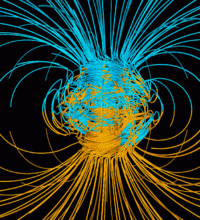
Photo from wikipedia
The problem of estimating the time derivatives of the horizontal components of the geomagnetic field and forecasting the probability of the occurrence of perturbations that exceed a given threshold level… Click to show full abstract
The problem of estimating the time derivatives of the horizontal components of the geomagnetic field and forecasting the probability of the occurrence of perturbations that exceed a given threshold level (the over-threshold perturbations) arises in the applications concerned with the geomagnetically induced currents (GICs). In this work, we consider the temporal and spatial structure of the Pi3 pulsations with quasi-periods of 102 to 103 s during which the auroral and subauroral stations of the IMAGE network record over-threshold values in the derivatives of the meridional (along the longitudinal circle) BX component and latitudinal (along the latitudinal circle) BY component. The extreme |dBX/dt| values mainly develop against the background of the Pi3 pulsations with a complex frequency content, whereas the extreme |dBY/dt| values appear when the buildup (decay) phases of the bay-like disturbance associated with the evolution of a substorm coincide with the respective phases of the field of pulsations. The conditions under which the derivatives |dBX/dt| and |dBY/dt| reach their over-threshold values are studied for subauroral latitudes by the technique of superposed epoch analysis. The extreme values of the derivatives most frequently occur during the main phase of moderate magnetic storms or beyond the storm—during high substorm activity under the conditions of a negative vertical component of the interplanetary magnetic field. The probability of the occurrence of over-threshold values increases at high amplitudes of the Pi3 pulsations and depends on their spectral content. The problem of analyzing and forecasting the over-threshold |dBY/dt| perturbations is complicated by the fact that the scale of the perturbations is small along the lines of latitude and large along the meridians. This can result in GIC excitation in the North–South oriented electric power lines by the geomagnetic perturbations localized within a narrow band in longitude which can be missed during the measurements.
Journal Title: Izvestiya, Physics of the Solid Earth
Year Published: 2018
Link to full text (if available)
Share on Social Media: Sign Up to like & get
recommendations!